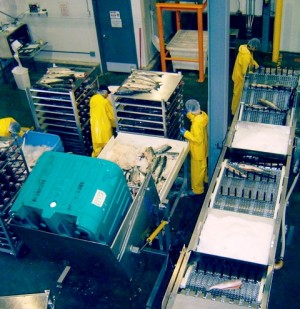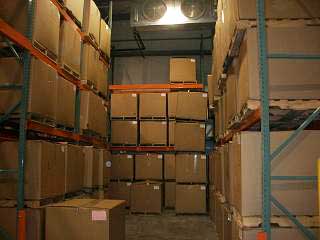Petersburg’s nonprofit cold storage plant is serving a wider group of customers than it did when it began about 10 years ago. It’s still mostly freezing fish for big processors but it’s also taking in groceries and sport anglers’ catches.

Petersburg Community Cold Storage holds up to a half-million pounds of product at a time and during its decade of operation most of that product has been pink salmon from big processors.
But that’s been changing.
“It’s kind of extended beyond just the idea of having seafood in there,” said Liz Cabrera, coordinator of the Petersburg Economic Development Council, which owns the plant.
She says it’s freezing and storing fish from smaller processors, as well as local businesses.
“The restaurants and the grocery stores and even some of the remote lodges will bring things in. And even the canneries will store groceries there,” she said.
It’s also being used more by hunters, charter operators and sport anglers without enough freezer space. Cabrera said one person brought in a moose.
Petersburg’s cold storage plant continues to give priority to its anchor tenant, Ocean Beauty.
“If they get a large delivery or large run of fish they can’t really handle at their plant they can bring it over and freeze it and hold it at the facility. They can also do freight consolidation so maybe they don’t have a container load yet of something they’re providing to a certain market. So they can hold product until they have a full container load,” she said.
The plant, on Petersburg’s waterfront, a half mile south of downtown, plays a somewhat different role for smaller seafood processors.
“They’ll hold frozen product there until maybe later in the season when they have time to smoke it or do some value-added processing. If they’re doing custom processing or maybe they don’t have enough room in their storage areas, they’ll bring excess over and hold it there until their customers can pick it up,” she said.
She said the economic development council has heard from some direct marketers interested in adding different types of processing to the facility.
They’re exploring options but she said it’s hard to do more in the same amount of space when there are no plans for expansion.

Cabrera says the public cold storage is already juggling smaller customers’ needs with those of the anchor tenant.
“Sometimes we’ll prioritize floor space and … have to block in maybe some of our other users in order to be able to accommodate our larger user and we’ll try to move them out as fast as we can, so we can get to things that are stacked up behind,” she said.
Volume – and income – is better this year than last. Smaller fish runs from July 2014 to June 2015 brought in gross revenues of about $125,000. July, August and September of last year alone brought in 90 percent of that amount.
It’s representative of the ups and downs the facility has seen, as the salmon catch ebbs and flows and producers close or change hands.
Cabrera says overall, the operation has paid its own way.
“We try to even it out on the good years and save the money for the year we know is going to be a down year,” she said.
Good years included 2009 and 2013.
Along with the customers, the species frozen and stored have changed. Pink salmon still make up much of what’s in the facility. Unlike the early days, fish aren’t just blast-frozen and put into a shipping van.
“I think we see a lot more chum and eggs that we’re processing or holding in the facility than we did initially and then just holding more product for additional processing later on,” she said.
Petersburg Community Cold Storage construction was funded by the state Fisheries Economic Development Program and the Petersburg Economic Fund.
Its latest addition is a couple big totes to hold ice for sport and commercial fishermen, offered at no cost.
Ed Schoenfeld is Regional News Director for CoastAlaska, a consortium of public radio stations in Ketchikan, Juneau, Sitka, Petersburg and Wrangell.
He primarily covers Southeast Alaska regional topics, including the state ferry system, transboundary mining, the Tongass National Forest and Native corporations and issues.
He has also worked as a manager, editor and reporter for the Juneau Empire newspaper and Juneau public radio station KTOO. He’s also reported for commercial station KINY in Juneau and public stations KPFA in Berkley, WYSO in Yellow Springs, Ohio, and WUHY in Philadelphia. He’s lived in Alaska since 1979 and is a contributor to Alaska Public Radio Network newscasts, the Northwest (Public Radio) News Network and National Native News. He is a board member of the Alaska Press Club. Originally from Cleveland, Ohio, he lives in Douglas.




